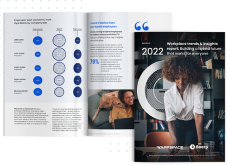
Why your financial organization needs to prioritize the employee experience
Mike Hicks
September 1, 2021The financial services industry is one to watch when it comes to digital transformation. Banks are making a hard push towards a digital-first, data-driven, customer-centric model. According to Forrester, these current trends are shaping the future of banking.
Even the most conservative financial institutions are accelerating their digital transformation to keep pace with rising customer expectations and increased competition from FinTechs.
Yet as important as the customer experience is – and will be in the years ahead – institutions would be wise to pay equal attention to employees’ evolving preferences and requirements.
There’s growing recognition in financial services that the employee experience (EX) is pivotal when it comes to the customer experience and an institution’s overall success. Organizations across many industries worldwide have already made this link, shifting their budgets to provide greater support for positive interactions across the employee life cycle.
In the rapidly transforming, fiercely competitive financial services sector, an intelligent digital workplace can help your organization gain an edge by creating a more connected, productive, and happy workforce.
There’s a talent problem in financial services
Attracting and keeping top talent in banking has been tough for well over a decade. And today’s generation of workers is looking for a better work-life balance than the one traditionally offered at banks.
Other challenges on the talent front include the rise of FinTechs, the shift to remote work, and mediocre employee engagement. It’s not surprising, then, that almost half of respondents in a recent PwC survey of retail bankers said talent constraints are a central concern.
The industry is known for high turnover rates – sometimes reaching 18%. A variety of factors are thought to contribute to this churn, from conservative corporate cultures that resist innovation to outdated technologies, but there’s widespread agreement that the sector is ripe for change.
To attract and keep top employees, financial institutions need to rethink the way people work.
Why the employee experience matters in financial services
It’s no secret that engaged employees achieve better business outcomes, including more engaged customers. And Gallup research shows that bank customers who are engaged represent 37% higher revenue than customers who aren’t. Yet a Salesforce survey found financial services ranked second last (after government) in rankings of how well different industries engage customers.
Employee engagement is even more vital in an industry that relies on trust and relationships. When workers are invested in their roles, they genuinely care about building customer relationships and delivering superior service.
While research shows only 21% of organizations include employee experience goals in their business unit strategies, 74% of those that do find it’s an effective strategy. In the current landscape, it’s time for financial institutions to be proactive about ensuring workers have all the tools and resources they need to feel satisfied in their work and motivated to provide optimal customer service.
To attract and keep top employees, financial institutions need to rethink the way people work.
It’s going to take more than financial incentives
Compared to other industries, the banking industry is known for its hefty bonuses and other financial benefits. Yet research from McKinsey and others shows that, for workers with sufficient salaries, some non-financial motivators are more effective than extra money in building long-term employee engagement.
On the flip side, the banking sector isn’t known for its vibrant culture or high employee engagement. This is partly because many financial institutions’ ways of working are constrained by regulations, making it hard for them to meet the expectations of today’s employees.
Modern workers are looking for the same ease and efficiency in their work lives that they experience as consumers in an increasingly digital world. They want a more social and innovative approach to work than many banks can currently offer.
The right technology can boost the employee experience
In a recent Accenture survey, 71% of financial services leaders acknowledged that their employees are far more digitally mature than their organization. This makes perfect sense, considering that Gartner says only 12% of financial services organizations are currently mature in their digital transformation.
The industry still has a fair way to go. But 2020 kickstarted many institutions’ efforts to move forward. Deloitte found 47% of banks in North America plan to implement new technology for enhanced efficiency and better financial and operational stability in the post-pandemic environment.
An investment in an intelligent digital workplace to replace outdated, rarely used intranets enables financial institutions to provide the consumer-like experience today’s employees expect, including:
- Simple, efficient collaboration no matter where or when people are working
- Quick and easy access to all the information they need to stay in the loop
- Streamlined, unified workflows powered by artificial intelligence
An intelligent digital workplace also promotes employee wellbeing, engagement, and overall happiness – with two capabilities that are uniquely suited to this era of remote work:
Employee recognition
Every employee wants to feel valued and have their hard work noticed. And Forbes reports that most workers would like more feedback than they currently get.
An intelligent digital workplace offers an easy way to regularly say ‘thank you’ to employees and colleagues. You can call out individual and team successes in multiple ways, from sharing positive customer feedback and celebrating work anniversaries to crowd-sourcing nominations for employee of the month.
Conversation and connection
One of the primary challenges of remote work, according to MIT research, is the loss of “passive knowledge sharing.” Put simply, there are fewer opportunities for spontaneous, informal conversation.
In an intelligent digital workplace, there are dedicated spaces for team or institution-wide discussions that capture the spirit of water cooler chat. Employees can share ideas, spark debates, catch up on personal news and maintain the critical connections that create a strong culture and sense of belonging. It’s the perfect solution for a culture tune-up.



